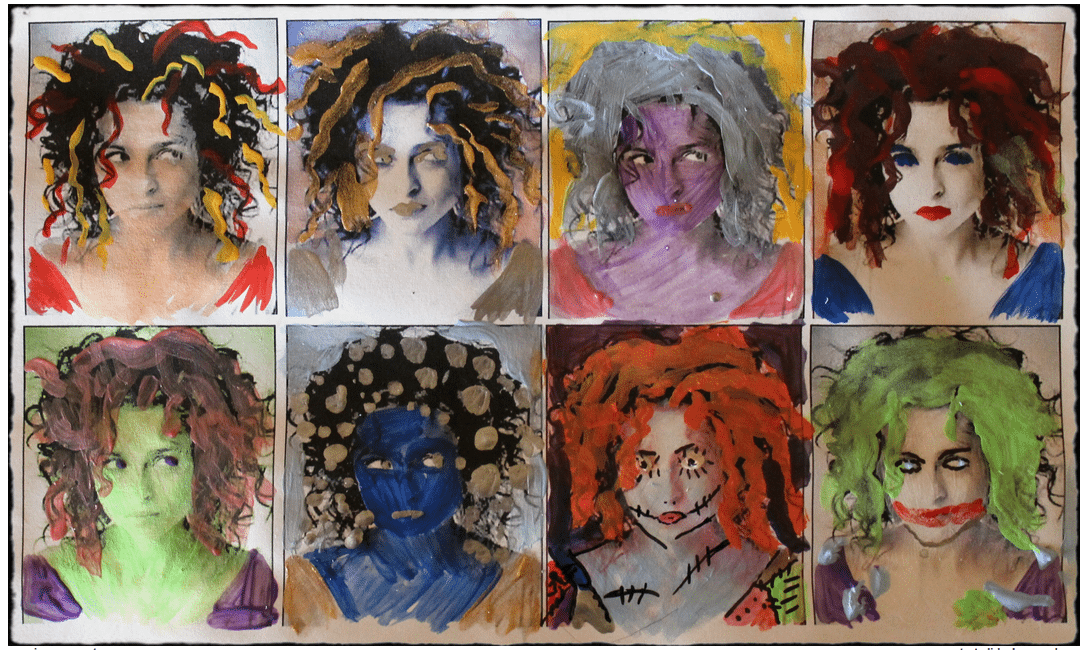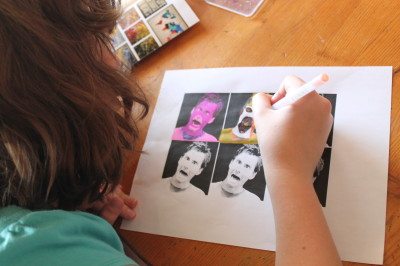
The Artist: Andy Warhol

Andy Warhol was an American artist, filmmaker, printmaker, and photographer, who led the Pop Art movement with colorful flair, most prominently in the 1960s.
Unlike abstract art that was popular in the 1950s, Pop Art often depicted immediately recognizable subjects, from cartoon characters to everyday items.
One of Warhol’s most recognizable examples of this was his Campbell’s Soup series of simple paintings on canvas. The soup can, an unlikely model for a portrait series, may have been indirectly inspired by a fellow artist of Warhol’s who told him to paint what he loved. The soup cans were part of his first major exhibition, and he claimed to have had the soup nearly everyday for lunch.
Warhol also liked to work with monoprinting (making “one-time” prints), silk-screening, using slide projections to trace drawings from projections, and experimenting with nearly every form for visual art.
He started out in the 1960s as a commercial illustrator, but soon moved away from commercial work into the world of popular art. His bohemian and counterculture attitude and appearance soon made him a celebrity in his own right, and he was dubbed the “Pope of Pop.” Actors, poets, musicians, and models were just a few of the people wanting to be part of his circle of friends. He has also been the subject of paintings, poems, documentaries, and even two children’s books, written and illustrated by his nephew, James Warhola.
Warhol passed away in 1987, but his work still feels new and current to many art lovers. In 2011, New York auction house Christie’s sold his painting of Elizabeth Taylor for more than $622,000, while his Double Elvis print was sold by Sotheby’s Auctions for $37 million.
The Project: “Geeky” Icons Portrait Series
One of Warhol’s techniques was to use images of popular individuals at the time, primarily historic figures and entertainers, such as Marilyn Monroe, John Wayne, Elizabeth Taylor, or Mick Jagger, and “re-imagine” them through changes in color schemes that go beyond what one would normally associate with a portrait.

Warhol’s silk-screen method was very precise and similar to how mass-produced prints were made. He used this method because he felt many of the celebrities themselves were “mass produced,” existing on paper and film as much as in their regular human form.
Since Warhol was very in tune with the current materials and methods of printmaking and commercial art at the time, one might imagine what he could have accomplished with modern-day, computer-based methods and photo apps. Whether or not he would have been happy with this progress, no one knows.
This project combines the best of both worlds—computer-based art and hand painting—in a tribute to both Warhol’s Icons and today’s geeky fandoms.
First, find a head shot of a favorite geeky icon—Stan Lee, Princess Leia, a Walking Dead zombie, etc.—and use any photo-editing program to make them black and white or a sepia tone. Another way is to take a color print and simply make black-and-white copies.

Copy and paste four to eight images of this photo, using any desktop publishing program.
Those who might not have one of these programs can print out as many copies of the image as they need, and cut and paste them by hand on a letter-size sheet. Don’t use the “pop art” or Warhol-inspired pre-done apps for this project, as they often don’t go beyond changing the background or image colors.
Once the repeated image has been printed, use whatever medium is desired to give each image its own unique personality. Felt tip markers, watercolors, colored pencils, and even crayons will work, depending on the age and skill of the artist.
Pop Art projects often encourage artists to go beyond the conventional way of looking at things, as artists look for creating something new and clever out of normal everyday images.
Even with this “no rules” attitude, there are three rules for this geeky project:
1. Use at least three different colors on each image.
2. Don’t make any two images the same. The whole point is to stretch the creative chords as far as possible.
3. Think about what would make Andy smile. Warhol and his art might not have appealed to everyone, but it wasn’t boring. Have fun and don’t be afraid to giggle a little at the results.
Even though this method is a little different and much less complicated than the one Warhol himself used, he might approve. After all, his definition of Pop Art was open to experimentation, imagination, and new ways of doing things.
“The pop idea was that anybody could do anything,” Warhol said. “So naturally, we were all trying to do it all.”



